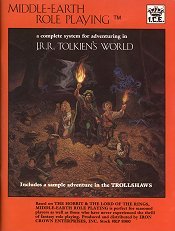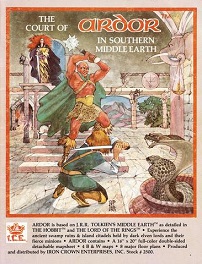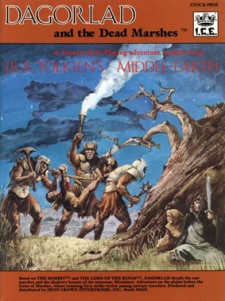
Isengard and Northern Gondor is a 1983 fantasy role-playing game supplement published by Iron Crown Enterprises for Middle-earth Role Playing .

Isengard and Northern Gondor is a 1983 fantasy role-playing game supplement published by Iron Crown Enterprises for Middle-earth Role Playing .
Isengard and Northern Gondor is a campaign module that details the plains of Calenardhon (which later became Rohan) in Northern Gondor, and Saruman's tower of Orthanc at Isengard. [1]
William A. Barton reviewed Isengard and Northern Gondor in The Space Gamer No. 73. [1]

Rohan is a fictional kingdom of Men in J. R. R. Tolkien's fantasy setting of Middle-earth. Known for its horsemen, the Rohirrim, Rohan provides its ally Gondor with cavalry. Its territory is mainly grassland. The Rohirrim call their land the Mark or the Riddermark, names recalling that of the historical kingdom of Mercia, the region of Western England where Tolkien lived.

Middle-earth Role Playing (MERP) is a 1984 role-playing game based on J. R. R. Tolkien'sThe Lord of the Rings and The Hobbit under license from Tolkien Enterprises. Iron Crown Enterprises (I.C.E.) published the game until they lost the license on 22 September 1999.
In J. R. R. Tolkien's fantasy writings, Isengard is a large fortress in Nan Curunír, the Wizard's Vale, in the western part of Middle-earth. In the fantasy world, the name of the fortress is described as a translation of Angrenost, a word in the elvish language, Sindarin, that Tolkien invented.

Iron Crown Enterprises (ICE) is a publishing company that has produced role playing, board, miniature, and collectible card games since 1980. Many of ICE's better-known products were related to J. R. R. Tolkien's world of Middle-earth, but the Rolemaster rules system, and its science-fiction equivalent, Space Master, have been the foundation of ICE's business.

In J. R. R. Tolkien's high fantasy The Lord of the Rings, Harad is the immense land south of Gondor and Mordor. Its main port is Umbar, the base of the Corsairs of Umbar whose ships serve as the Dark Lord Sauron's fleet. Its people are the dark-skinned Haradrim or Southrons; their warriors wear scarlet and gold, and are armed with swords and round shields; some ride gigantic elephants called mûmakil.

The Lord of the Rings: The Battle for Middle-earth is a 2004 real-time strategy video game developed by EA Los Angeles for Microsoft Windows. The first part of the Middle-earth strategy game, It is based on Peter Jackson's The Lord of the Rings film trilogy, in turn based on J. R. R. Tolkien's original novel. The game uses short video clips from the movies and a number of the voice actors, including the hobbits and wizards. It uses the SAGE engine. The sequel, The Lord of the Rings: The Battle for Middle-earth II, was released on March 2, 2006.

Middle Earth Strategy Battle Game, previously marketed as The Hobbit: An Unexpected Journey Strategy Battle Game, The Hobbit: The Desolation of Smaug Strategy Battle Game, The Hobbit: The Battle of Five Armies Strategy Battle Game and The Lord of the Rings Strategy Battle Game, is a tabletop miniature wargame produced by Games Workshop. It is based on The Lord of the Rings film trilogy directed by Peter Jackson, and the book that inspired it, written by J. R. R. Tolkien.

War of the Ring is a strategy board game by Roberto Di Meglio, Marco Maggi and Francesco Nepitello, first produced by Nexus Editrice (Italy) and currently published by Ares Games.
In J. R. R. Tolkien's Middle-earth writings, the Dúnedain were a race of Men, also known as the Númenóreans or Men of Westernesse. Those who survived the sinking of their island kingdom and came to Middle-earth, led by Elendil and his sons, Isildur and Anárion, settled in Arnor and Gondor.
The geography of Middle-earth encompasses the physical, political, and moral geography of J. R. R. Tolkien's fictional world of Middle-earth, strictly a continent on the planet of Arda but widely taken to mean the physical world, and Eä, all of creation, as well as all of his writings about it. Arda was created as a flat world, incorporating a Western continent, Aman, which became the home of the godlike Valar, as well as Middle-earth. At the end of the First Age, the Western part of Middle-earth, Beleriand, was drowned in the War of Wrath. In the Second Age, a large island, Númenor, was created in the Great Sea, Belegaer, between Aman and Middle-earth; it was destroyed in a cataclysm near the end of the Second Age, in which Arda was remade as a spherical world, and Aman was removed so that Men could not reach it.

A Campaign and Adventure Guidebook for Middle-earth is a 1982 fantasy role-playing game supplement published by Iron Crown Enterprises.
Umbar: Haven of the Corsairs is a 1982 fantasy role-playing game supplement published by Iron Crown Enterprises.

Rogue 417 is a 1984 role-playing game supplement for Fringeworthy published by Tri Tac Games.

The Court of Ardor in Southern Middle Earth is a 1983 fantasy role-playing game supplement published by Iron Crown Enterprises for Middle-earth Role Playing.

Northern Mirkwood: The Wood-Elves Realm is a 1983 fantasy role-playing game supplement published by Iron Crown Enterprises for Middle-earth Role Playing.

Southern Mirkwood: Haunt of the Necromancer is a 1983 fantasy role-playing game supplement published by Iron Crown Enterprises for Middle-earth Role Playing.

Bree and the Barrow-Downs is a 1984 fantasy role-playing game adventure published by Iron Crown Enterprises for Middle-earth Role Playing.

Dagorlad and the Dead Marshes is a 1984 fantasy role-playing game adventure published by Iron Crown Enterprises for Middle-earth Role Playing.
The Tower of Cirith Ungol and Shelob's Lair is a 1984 fantasy role-playing game adventure published by Iron Crown Enterprises for Middle-earth Role Playing.
The architecture in Middle-earth is as varied as the Hobbit-holes of the Shire, the tree-houses of Lothlórien, the wooden halls of Rohan, and the stone dwellings and fortifications of Minas Tirith, capital of Gondor. Tolkien uses the architecture in each place, including its interior design, to provide clues to each people's character. The Hobbit Bilbo Baggins's cosy home, Bag End, described in his 1937 children's book The Hobbit, establishes the character of Hobbits as averse to travelling outside the Shire. In his fantasy novel The Lord of the Rings, Lothlórien demonstrates the close integration of the Elves with their natural environment. The King of Rohan's hall, Meduseld, indicates the Rohirrim's affinity with Anglo-Saxon culture, while Gondor's tall and beautiful stone architecture was described by Tolkien as "Byzantine". In contrast, the Dark Lord Sauron and the fallen Wizard Saruman's realms are damaged lands around tall dark towers.